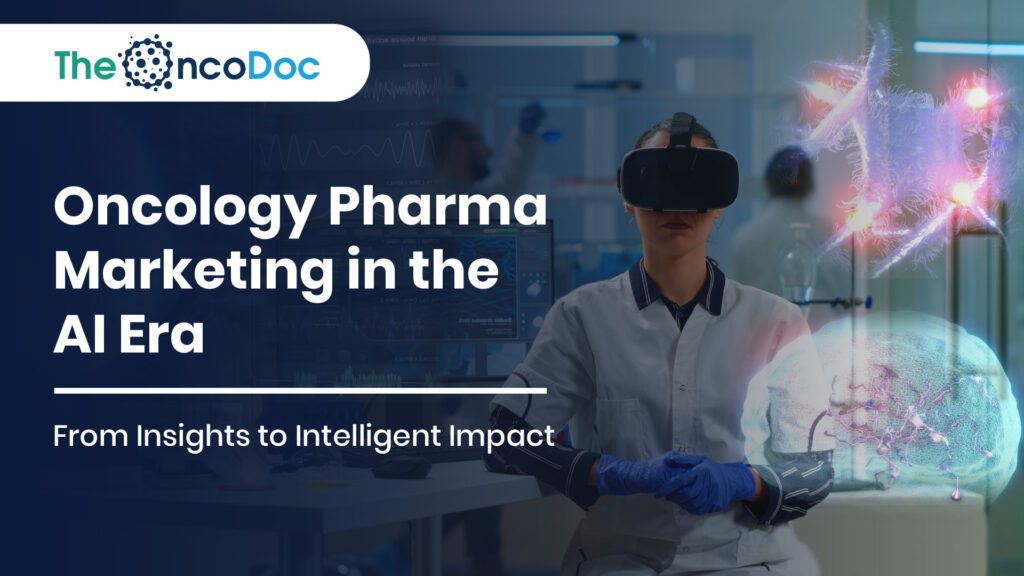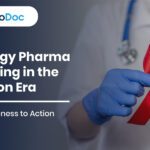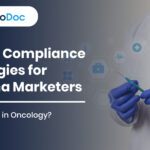Introduction: The New Imperative in Oncology Pharma Marketing
Oncology has always been one of the most rapidly evolving therapeutic areas, but the convergence of AI, precision medicine, and digital ecosystems is creating a new playbook for pharma marketers. The old model, primarily dependent on detailing, awareness campaigns, and static educational content, no longer resonates in a world where oncologists expect real-time insights, dynamic clinical tools, and outcome-driven collaboration.
With cancer care becoming increasingly data-heavy, driven by genomic testing, real-world evidence (RWE), and AI-assisted diagnostics, the role of pharma is shifting from brand promotion to decision support and ecosystem enablement.
This article explores how oncology pharma marketers can strategically integrate AI to deliver personalized, value-centric engagement that supports oncologists, care teams, and patients. We will look at data-backed trends, AI-powered personalization, cross-functional collaboration, and compliance-friendly innovation, while also highlighting practical strategies to build credibility in the oncology landscape.
1. From Awareness to Action: Redefining the Oncology Brand Narrative
Traditional metrics like reach and recall no longer define success in oncology marketing. In today’s high-pressure clinical environment, oncologists prioritize content that supports decisions, not just promotions. A 2025 global study of 1,800 oncologists found that 42% prefer decision-support tools, 29% favor real-world evidence dashboards, and only 10% engage with conventional promotional materials.
Insight: Addressing actual clinical issues is increasingly necessary for effective marketing.
Action for Pharma:
- Focus on value-first communication: launch tools that reduce diagnostic ambiguity or enhance therapeutic decision-making.
- Integrate AI-backed clinical updates, not as brand pushes, but as knowledge assets tailored to real clinical needs.
2. AI-Powered Personalization: Moving Beyond Segmentation
AI allows pharma to deliver hyper-personalized engagement that adapts to oncologists’ specialties, practice settings, and learning preferences.
Example:
An AI-enabled CRM for an oncology immunotherapy brand analyzed physician behavior across India:
- Hematologists were 2.8× more responsive to deep-dive mechanism-of-action (MOA) PDFs.
- Breast cancer oncologists showed a preference for concise, AI-created case summaries shared over WhatsApp ahead of their morning consultations.
- Tier-2 oncologists engaged 4× more with regional-language decision tools.
Pharma Strategy:
- Use predictive engagement models to determine when and how to reach each oncologist.
- Enable multi-channel personalization, push concise voice notes to busy clinicians, interactive dashboards to researchers, and region-specific patient guides for community oncologists.
3. AI-Enhanced Decision Tools: From Brand Communication to Clinical Utility
In oncology, the most impactful brand assets are tools that seamlessly integrate into daily clinical workflows.
High-Value AI-Driven Tools:
- Genomic Report Translators –These tools translate intricate biomarker panels into practical therapy suggestions.
- Toxicity Prediction Dashboards – analyzing patient profiles to flag high-risk adverse events.
- Treatment Sequencing Planners – suggesting evidence-backed regimens considering prior therapies and comorbidities.
Insight: Oncologists prefer AI tools that reduce complexity and directly support therapeutic decisions. Perceived clinical value is highest for toxicity predictors and genomic report translators.
Case Example:
A lung cancer brand launched an AI-powered EGFR mutation detection support tool, integrated directly with partner pathology labs.
- 4,500 oncologists enrolled in six months.
- 23% reduction in time-to-treatment initiation.
- 17% more people are using the right first-line treatment.
4. Empowering Oncology Sales Teams with AI-Driven Insights
While digital channels are powerful, field forces remain essential in oncology marketing, but their role is transforming.
AI-Powered Rep Enablement:
- AI-driven call planners recommend the most relevant content based on the oncologist’s recent interactions.
· During meetings, adaptive detailing apps make real-time content changes.
- Generative AI note summaries help reps deliver tailored follow-ups.
Impact:
A GI oncology brand in South Asia integrated its rep tools with AI analytics. Within six months:
- 61% improvement in perceived meeting relevance.
- 39% increase in engagement with clinical decision tools post-meeting.
- 45% reduction in rejected visit requests.
5. Multilingual & Tiered Engagement: Reaching Every Oncology Touchpoint
Metro hospitals are only one aspect of cancer care. Although there is a lot of unrealized potential in Tier-2 and Tier-3 cities, participation there necessitates linguistic and cultural adaptation.
AI + Language Enablement:
· Install chatbots for treatment FAQs in Hindi, Bengali, Tamil, and Marathi.
- Utilize synthetic voice technology to deliver MOA content in native languages, enhancing comprehension across diverse geographies
- Distribute localized patient diet guides co-developed with regional nutritionists.
Example Impact:
A pharma-led regional breast cancer awareness series in Gujarati:
- 21% increase in early-stage diagnosis rates.
- 18% increase in therapy adherence among patients in rural areas.
6. Real-World Data (RWD) Dashboards: Building Evidence-Based Trust
RCTs remain essential, but oncologists increasingly rely on RWD to inform treatment decisions, especially in diverse populations.
AI-Enabled RWD Tools:
- City-wise toxicity trackers for chemotherapy regimens.
- Survival dashboards that contrast private and public care environments.
- Adherence analytics segmented by demographics.
Example:
Example: AI-linked RWD dashboards using EMR data from 40 hospitals were implemented by an Indian multiple myeloma brand:
- 12% increase in following the rules.
- 9% increase in oncologist trust scores.
- 16% growth in digital engagement.
7. Beyond the Oncologist: Engaging the Entire Cancer Care Team
Oncology is inherently multidisciplinary, nurses, pharmacists, dieticians, palliative care teams, and caregivers are critical stakeholders.
Pharma Enablement Strategies:
- AI-powered drug safety modules for hospital pharmacists.
- Digital nutrition planners linked to local diets for patients undergoing treatment.
- Mobile-based caregiver support solutions incorporating periodic psychological well-being evaluations.
Example:
An AI chatbot for oncology nurses improved chemotherapy administration adherence by 15% across partner hospitals in South India.
8. AI-Enabled Learning Communities: From Passive Learning to Active Collaboration
Oncologists value peer-driven dialogue over static brand content. AI can facilitate dynamic, interactive communities.
Insight: Dynamic, clinically contextual content far outperforms traditional formats in oncologist engagement.
Example:
A pharma-enabled Virtual Tumor Board Platform:
- 3,000 oncologists sharing anonymized cases.
- 120% increase in case discussion participation.
- 84% reported a clinical decision influenced by peer exchange.
9. AI with Compliance: Innovating Responsibly
Regulatory compliance is critical in oncology pharma marketing. AI must be deployed within ethical frameworks.
Best Practices:
- Avoid direct treatment recommendations; provide data layers instead.
- Maintain full transparency on AI tool logic.
- Ensure privacy-compliant anonymization of all patient data.
10. Metrics That Matter: Measuring Real-World Impact
In oncology AI marketing, success isn’t measured in impressions, but in improved decision quality and patient outcomes.
Key Metrics:
- Tool Reuse Rates – repeated usage indicates clinical value.
- Decision Impact – percentage of treatment plans influenced by tools.
- Patient Experience Scores – improved understanding and adherence.
Insight: Oncology marketers are shifting from surface-level KPIs to impact-based metrics, reflecting real-world relevance and adoption.
11. Predictive Analytics in Oncology Marketing: Anticipating Needs Before They Arise
One of the biggest advantages AI brings to oncology marketing is the ability to anticipate clinical needs before they become evident in day-to-day practice. Predictive analytics can identify emerging therapy adoption trends, anticipated diagnostic bottlenecks, and new educational demands.
Example:
An AI system analyzing prescription data across 120 oncology centers detected a surge in HER2-low testing in smaller hospitals, indicating early adoption of newer breast cancer therapies. The company used this knowledge to:
- Introduce micro-modules that educate community oncologists on HER2-low therapy algorithms.
- Provide diagnostic kits to partner labs before demand spiked.
- Provide patient education resources in the local languages beforehand.
This proactive approach improved brand positioning without direct promotion, reinforcing its role as a market enabler rather than a reactive participant.
12. AI-Driven Competitive Intelligence: Staying Ahead in an Evolving Market
The oncology market is highly competitive, with rapid product launches, new indications, and shifting therapy lines. AI tools can help pharma marketers track competitor movements in near real-time, identifying opportunities for differentiation.
Applications of AI Competitive Intelligence:
- Tracking trial updates and publication timelines to anticipate competitor product positioning.
- Social listening to detect sentiment shifts among oncologists regarding certain therapies.
- Benchmarking engagement strategies, understanding which competitor tools resonate most with HCPs.
Impact Example:
A melanoma drug team used AI to detect increasing conference buzz about a rival product’s new safety profile. This led them to:
- Develop side-by-side evidence comparison dashboards for oncologists.
· Start a series of videos featuring KOLs that discuss the changing risk-benefit equation.
13. AI-Enhanced Patient Pathway Mapping: Marketing That Mirrors Clinical Reality
Traditional marketing often focuses on treatment stages in isolation. However, cancer care is a long, complex journey from suspicion to survivorship. AI can map this journey using EMR, claims, and diagnostic data, enabling pharma to design interventions that align with real-world timelines.
Example:
An AI model revealed that in rural oncology centers, there was a three-week diagnostic gap between biopsy and biomarker test results. In response, a lung cancer brand:
- Partnered with labs to accelerate testing logistics.
- Provided AI-driven educational content to prepare clinicians for treatment initiation.
- Shared patient counseling kits to maintain engagement during waiting periods.
This approach built trust and loyalty, the brand was seen as addressing real bottlenecks in care delivery.
14. Integration with Digital Therapeutics (DTx): Expanding Pharma’s Role
AI-powered digital therapeutics are becoming a powerful adjunct to oncology treatments. Pharma can leverage DTx platforms to enhance outcomes and create ongoing engagement touchpoints.
Examples of Pharma-DTx Integration:
- Symptom monitoring apps that detect patterns in fatigue, nausea, or neuropathy.
- Cognitive-behavioral therapy modules supporting cancer-related anxiety.
- Nutritional AI tools adjusting diet plans according to treatment stage and side effects.
Case Example:
An immunotherapy brand integrated its patient support program with a DTx app for fatigue tracking. Results showed:
- 15% improvement in self-reported energy levels.
- 11% increase in treatment adherence rates.
- Positive perception of the brand as a holistic care partner.
15. AI in Market Access & Pricing Strategies: Value Communication at Scale
Market access in oncology is becoming more complex with precision therapies and high-cost biologics. AI can help pharma craft value narratives tailored to payers, policy makers, and hospital procurement committees.
Applications:
- Cost-benefit simulation models demonstrating real-world outcomes relative to spend.
- Regional budget impact calculators for hospital administrators.
- AI-driven patient assistance program optimizations to maximize reach within budget.
Example:
A CAR-T therapy brand used AI models to demonstrate that early intervention could reduce hospitalization costs by 18% for relapsed lymphoma patients. This insight accelerated hospital formulary inclusion.
16. Future-Proofing Oncology Pharma Marketing: Preparing for AI 2.0
AI in oncology marketing will evolve rapidly with next-generation models capable of deeper multimodal analysis (combining genomic, imaging, and clinical data). Pharma must prepare to integrate these advancements into their strategies.
Emerging Opportunities:
- Real-time therapy monitoring dashboards pulling live patient data from wearables.
- Synthetic patient population modeling to predict rare side effect trends.
- Immersive AR/VR tumor board experiences for interactive oncologist training.
Strategic Imperative:
The winners in this AI-driven era will be brands that adapt continuously, ensuring their marketing ecosystems remain aligned to the pace of scientific and digital innovation.
17. AI in KOL (Key Opinion Leader) Identification & Engagement: Precision Influence
In oncology, the influence of KOLs and emerging digital opinion leaders (DOLs) is significant, particularly in shaping therapy adoption and best practices. AI can now identify high-impact voices beyond traditional conference circuits by analyzing publication patterns, webinar participation, and social engagement.
AI-Driven KOL Strategies:
- Network mapping to detect collaborative clusters in oncology specialties.
- Identifying regional micro-KOLs in Tier-2 and Tier-3 markets with strong peer influence.
- Using AI sentiment analysis to align engagement with KOLs whose views resonate with evolving clinical narratives.
Example:
An oncology biosimilar brand used AI mapping to identify three under-recognized oncologists in Central India who frequently led hospital case reviews. By involving them in peer-learning modules, the brand’s educational reach in the region increased by 47% within 8 months.
18. AI for Omni-Channel Campaign Optimization: A Continuous Learning Loop
Omni-channel engagement is now the norm, but content must adapt dynamically to maximize impact. AI enables real-time tracking of how oncologists interact with materials across email, WhatsApp, CME platforms, conference apps, and in-person meetings.
AI Use Cases:
- Adjusting content frequency to match engagement patterns.
- Replacing underperforming formats (e.g., static PDFs) with interactive visuals based on response rates.
- Predicting optimal channel combinations for different oncologist profiles.
Example:
A breast cancer brand found that oncologists in urban metros were 3.5× more responsive to CME videos sent 48 hours after conference participation than to pre-event promotional materials. AI-driven timing adjustments improved post-event engagement by 60%.
19. AI-Powered Patient Segmentation & Education: Extending Value Beyond HCPs
Oncology brands are increasingly supporting patients and caregivers directly, especially with complex treatment regimens. AI helps segment patient groups based on diagnosis stage, treatment type, language, and adherence behavior.
Applications:
- Personalized chatbot assistants guiding patients through treatment timelines.
- AI-translated video explainers adapted to literacy levels and regional dialects.
- Behavioral prediction models to trigger early adherence interventions.
Example:
A colorectal cancer therapy integrated an AI-based patient support platform. This segmented patients into five risk-adherence clusters, enabling targeted reminders and customized diet plans. Results:
- 20% improvement in follow-up adherence.
- 13% reduction in emergency visits due to missed supportive care.
20. Sustainability & Ethical AI in Oncology Marketing: Building Long-Term Trust
As AI becomes embedded in oncology marketing, sustainability and ethics become brand differentiators. AI adoption must be transparent, unbiased, and compliant, ensuring its credibility among oncologists and regulators.
Best Practices for Ethical AI in Pharma:
- Bias testing in predictive engagement tools to avoid over-targeting certain demographics.
- Explainability, clearly documenting AI model logic for medical review boards.
- Data sustainability, minimizing redundant data storage and ensuring secure patient data handling.
Strategic Advantage:
Brands that are seen as ethical AI pioneers will not only comply with regulatory expectations but will also earn durable trust from the oncology community.
Conclusion: Pharma’s Evolving Identity in AI-Driven Oncology
In an AI-centric oncology landscape, pharma is no longer a promoter, but a partner in care. By creating decision tools, multilingual resources, real-world evidence platforms, and AI-enabled learning ecosystems, brands can build enduring trust.
The next era of oncology pharma marketing will be defined by relevance, personalization, and measurable impact, not by louder campaigns, but by smarter, context-aware contributions.
👉 Bottom Line: In oncology, don’t just market a molecule, empower a moment of care.
The Oncodoc team is a group of passionate healthcare and marketing professionals dedicated to delivering accurate, engaging, and impactful content. With expertise across medical research, digital strategy, and clinical communication, the team focuses on empowering healthcare professionals and patients alike. Through evidence-based insights and innovative storytelling, Hidoc aims to bridge the gap between medicine and digital engagement, promoting wellness and informed decision-making.



